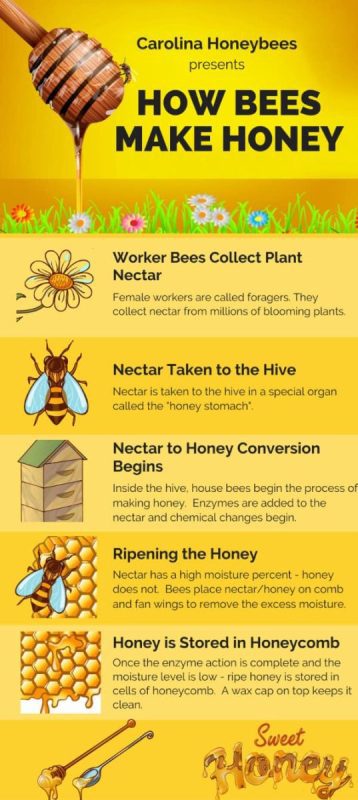
How bees make honey: a step-by-step description of the process
How do bees make honey? – probably at least once thought all the people, enjoying this healthy treat. Of course, we all know in general terms that hard-working insects collect something in flowers – hence honey comes from. However, such information is clearly not enough to satisfy curiosity, so we will talk about such an interesting process in more detail. Moreover, there really is something to talk about!
Contents
Why do bees make honey
Honey bees need for the same thing for which man also uses it as food. Without proteins, carbohydrates and fats insects are unavoidable. Nectar It is also an excellent source of carbohydrates. After all, in fact, it is a liquid solution, consisting of sugars – 20% water accounts for as much as 80% of glucose. A bee cannot live without carbohydrates absolutely. And pollen gives protein.
But, in addition to sugars, many other substances can be found in the nectar that benefit the bees. For example, we are talking about vitamins C, E, K, the whole group B, folic acid, carotene. By the way, in the process of its creation, honey is enriched with other useful components.
Keep honey can be much longer than nectar – it is for this reason that bees recycle last. Processed nectar is available for goodies for a very long time, which, in fact speaking, the bees achieve. Similar their stocks help out a lot during the whole of the year. They feed on such stocks themselves bees and their larvae.
INTERESTING: Not everyone knows, but the larvae absorb not only nectar, but also bee bread. Perga is, colloquially, “pollen”.
Remarkably, that if you want to change the hive bee does not fly away easily. She is gaining in the goiter as much honey as you can carry behind you. If she doesn’t, then in a new place risks starving to death. After all, when will the new harvest honey!
Most of all, the bee needs this sweetness in the summer. The fact is that in winter the bees gather closer to each other and consume much less food. For comparison: out of 70-90 kg of honey eaten by a family of bees per year, only 10-12 kg are eaten in winter.
Honeycombs: how they are built, from what
А How are honeycombs created? honey formed?
- To begin with, insects find a secluded place for construction. It is very important that rains and colds are not typical for this place.
- Having decided on the previous moment, the bees begin to produce wax. This is the main building material, without which honeycombs will not work. And it is produced just from the abdomen! Special glands are responsible for this moment. It is believed that one flake of wax created by a bee weighs about 6,8 mg. And for combs designed for one family of insects, about 4 to 6 kg of wax should go!
- The bee must stock up on a large amount of honey – without them, the wax does not stand out. On average, it takes about 1 kg of honey to create 3 kg of wax. It turns out an interesting phenomenon: in order to create honey, an insect needs to spend honey.
- Next, the bees create a kind of living chain. The top one is attached to the top of the nest. Another bee is attached to its paws – and this is how a chain is formed. The lower insect, starting to secrete wax, moves up the chain, simultaneously grinding the wax and mixing it with secretions from the glands of the jaws.
- The resulting mass of the bees is divided and neatly stacked. It turns out a whole structure, which is a honeycomb. Honey will be located in the upper cells and cells located on the side. It is curious that the cells have a hexagonal shape for a reason. According to scientists, this form is not in vain chosen by bees – it allows you to accommodate the maximum product, but at the same time it takes a minimum of wax to make it.
How bees make honey: description process step by step
А how is the delicacy itself formed?
- Talking about how bees make honey, we must, of course, mention the initial stage of this process. That eats, about the very collection of nectar. To do this, insects have a special proboscis. They sit down on the plant they like – and suck in the juice with sugar, which we call “nectar”. The type of finished product depends on what exactly the bee visited – that is, the result will be acacia, buckwheat, chestnut, clover honey. But how do bees find nectar? From the hive, several “scouts” are sent into flight, who collect nectar in the goiter and fly back.
- At home, they perform a special dance, which shows where they should fly, and the nectar brought helps future “miners” to understand what the smell of the right plants is.
- Then the “getters” go for the harvest. It is believed that during one such flight, the bee brings about 70 mg of nectar. They bring it in the goiter, as already written earlier. This is a special compartment next to the stomach. This compartment is separated from the stomach by a special valve. The goiter serves as a kind of food basket, but some of the nectar can get into the stomach if the bee wants to try it. An insect can completely fill such a “basket” in about half an hour.
- After the “getter” bee arrives in the hive, it transfers the nectar to the worker bee in its goiter. While the transfer is taking place, various enzymes get into the nectar, and this is normal. They just participate in the formation of honey.
- What will the worker bee do? She regurgitates some nectar from the goiter onto the proboscis, dries it, and then draws it back. Each such portion of nectar can fall on the proboscis and be dried about 120-250 times!
- Often the bee has to flap its wings. This action helps excess moisture to evaporate. Ready honey should have no more than 20% moisture. In the product of the highest grade, its percentage should not exceed 18,6%.
- After all this, the products are placed in honeycomb cells. The cells are sealed with wax. Now this blank only needs to ripen to the state of honey!
Certainly, because of the knowledge of how honey is made, a person will not taste it otherwise. But to know about all all the subtleties creating this delicacy is very interesting!





